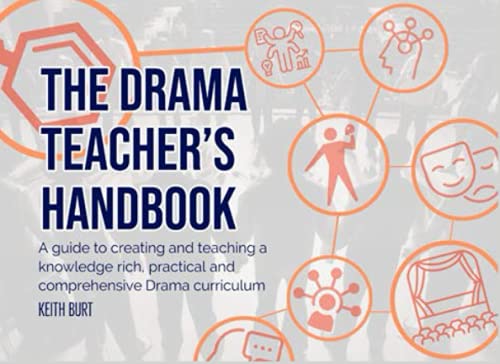The lack of any official KS3 National Curriculum is both a blessing and a curse for Drama teachers, forever allowing us to spread our creative wings in devising something engaging for our students whilst also hampering us with the constant worry that we have nothing official to measure it against. How do we know what we are teaching is coherent, valid, or indeed interesting? Luckily for us, we have a wonderful new aid in Keith Burt’s The Drama Teacher’s Handbook; a concise and accessible guide that offers a wealth of pedagogical theory, practical tips and a welcome emphasis on self-reflection.
Each chapter offers a short foray into understanding the key concepts necessary to ensure that you have the strong foundations needed for a broad and balanced curriculum, practical advice as to how that might be administered, and ends with a section called ‘Reflection/ Response/ Resource’; a brilliant way to stretch your own learning by offering up a series of questions, tasks and further reading to reinforce your own understanding.
Burt spends a great deal of time discussing the importance of knowledge and how it can be constructed to ensure a high level of understanding in students through a ‘broad and balanced, deep and detailed’ delivery using a wide range of practitioners, genres, and design elements that practical skills can be linked to. He then looks at how you can develop schema and create an environment that helps to ensure that the learning you have put into place is reinforced with retrieval practices that won’t lead to students becoming overwhelmed – a problem that we are all aware of especially post-covid. Although he also looks at the ideas of summative and formative assessment as a way to measure the impact of the curriculum it is in the chapters where he explores the concept of ‘cultural capital’ where the reader can really start to acknowledge the importance of an effective drama curriculum in shaping the lives and attitudes of young people; where we can celebrate the idea of Drama being a ‘soft skills subject’ rather than see that label as demeaning.
Burt finishes his book with a variety of workable resources, including assessment grids, grading tools, lesson plan outlays and a great 10 step guide to creating your curriculum which basically boils down every chapter into a succinct and workable sentence – what more could you want! Do not expect a guide that will tell you exactly what to teach or a resource of lesson plans and schemes of work, you need to approach the book with ideas in mind and use it to hone those ideas into something potent and effective. Whether you are a trainee teacher looking at how to start or a seasoned head of subject craving a tool for self-reflection there is something here for everyone and all delivered in a way that can be read cover to cover or dipped into as and when you are craving some inspiration.
By the book here: The Drama Teacher’s Handbook: A guide to Creating and Teaching a Knowledge Rich, Practical and Comprehensive Drama Curriculum
This book review has been kindly written by Matthew Springett, Head of Drama at The Skinners’ Kent Academy in Royal Tunbridge Wells, Kent - an all ability Academy where the Arts sit within a specialist faculty and are truly valued. You can follow him on Twitter @Springface.


